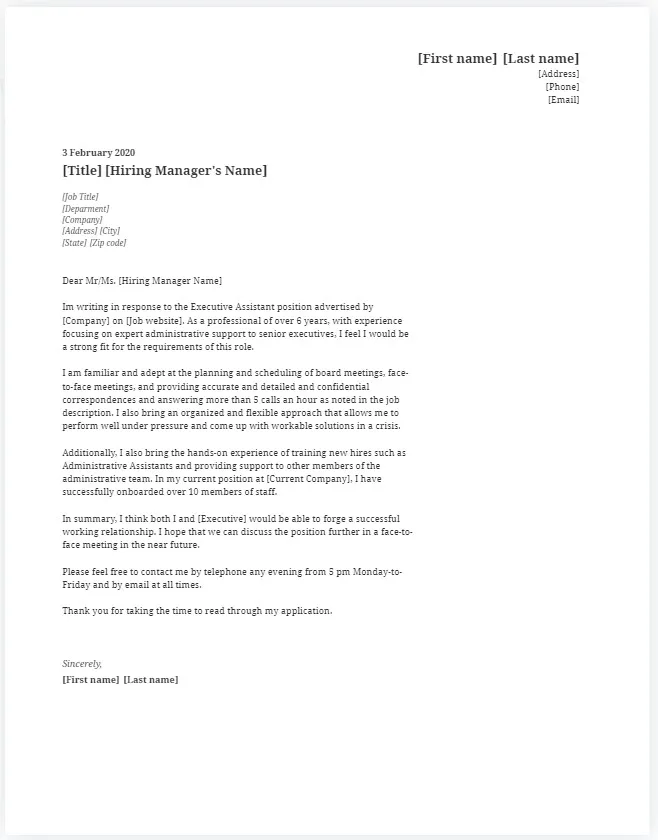Crafting a Compelling Resume Cover Letter
In the competitive landscape of job applications, a resume cover letter serves as your first impression, offering a crucial opportunity to showcase your personality, skills, and qualifications. A well-crafted cover letter can significantly increase your chances of landing an interview, while a poorly written one can lead to immediate rejection. For aspiring executive assistants, a strong cover letter is especially important, as it demonstrates your attention to detail, communication skills, and understanding of the role’s demands. This guide provides a comprehensive approach to writing an effective resume cover letter, helping you stand out from the competition and secure your desired position.
Understanding the Importance of a Cover Letter
A cover letter is more than just a formality; it’s a vital tool in your job-seeking arsenal. While your resume provides a snapshot of your experience and skills, the cover letter allows you to tell your story, explaining why you are the perfect fit for the role and the company. It provides context to your resume, highlighting specific achievements and demonstrating how your skills align with the job requirements. For executive assistants, a well-written cover letter shows your ability to communicate professionally, organize your thoughts effectively, and understand the needs of the executive you will support. In essence, the cover letter is your chance to make a personalized pitch, setting the stage for a successful application.
Key Components of an Effective Cover Letter
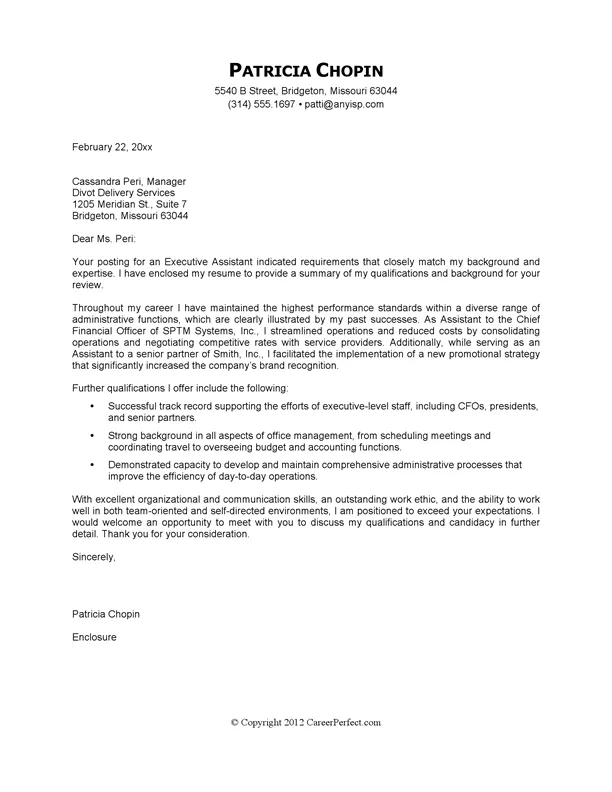
A successful cover letter has several key components working together to create a positive impression. These elements include a clear and concise introduction, a compelling body that highlights your relevant skills and experience, and a strong closing that calls for action. Each section should be carefully crafted to demonstrate your understanding of the role and the company’s needs. The best cover letters are tailored to each specific job application, showing that you have taken the time to research the company and understand what they are looking for. Furthermore, they should be free of grammatical errors and typos, showcasing your attention to detail.
Contact Information and Introduction
Begin your cover letter with your contact information, including your name, phone number, email address, and LinkedIn profile URL. Follow this with the date and the hiring manager’s name and title, if known. The introduction is crucial, as it sets the tone for the rest of the letter. State the position you are applying for and where you found the job posting. Briefly mention what makes you a strong candidate and express your enthusiasm for the role and the company. For example, you might mention a specific project you’re excited about or a value that aligns with the company’s mission. This initial paragraph should grab the reader’s attention and encourage them to continue reading.
Highlighting Your Skills and Experience
The body of your cover letter is where you showcase your skills and experience, demonstrating how they align with the job requirements. Focus on the most relevant skills and achievements, providing specific examples to support your claims. For executive assistants, emphasize skills such as communication, organization, time management, and proficiency in office software. Instead of simply listing your skills, explain how you have used them to achieve positive outcomes in previous roles. Quantify your achievements whenever possible, using numbers to illustrate your impact. For example, you might mention how you improved efficiency by a certain percentage or streamlined a specific process. This section should be tailored to the specific job description, ensuring that you address the key requirements mentioned.
Showcasing Relevant Achievements
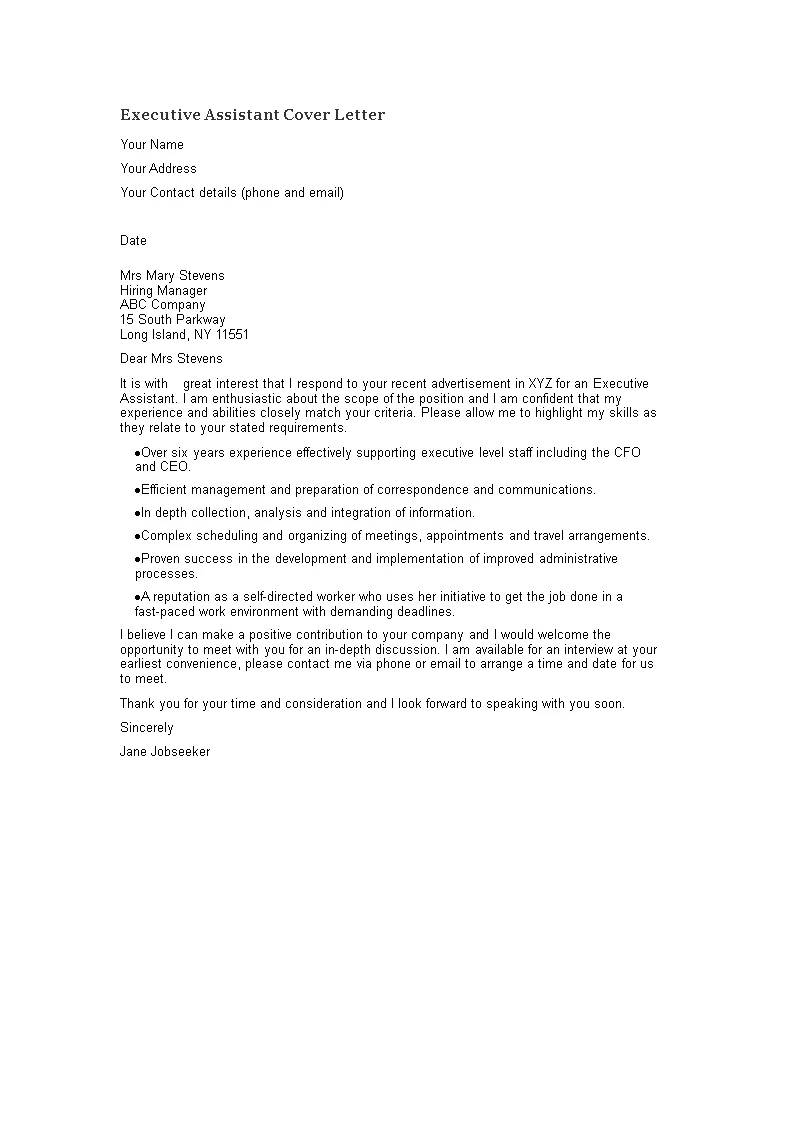
Go beyond simply listing your responsibilities; focus on your accomplishments and the results you achieved in previous roles. Use the STAR method (Situation, Task, Action, Result) to provide a clear and concise narrative of your achievements. Briefly describe the situation you were in, the task you had to accomplish, the actions you took, and the results you achieved. For example, if you improved the efficiency of a scheduling process, describe the previous process, the steps you took to improve it, and the specific benefits it provided. By quantifying your achievements and demonstrating the positive impact you had, you can convince the hiring manager that you are a valuable asset.
Tailoring Your Cover Letter to the Job
One of the biggest mistakes applicants make is sending a generic cover letter. Tailoring your cover letter to each specific job application is essential to demonstrate your genuine interest in the role and the company. Carefully review the job description and identify the key skills and requirements. Then, adjust your cover letter to highlight the skills and experiences that are most relevant. Use the same keywords and phrases that are used in the job description to show that you understand what the employer is looking for. This level of personalization shows that you have taken the time to understand the specific needs of the role and the company, making you a more compelling candidate. Furthermore, ensure that you address the specific needs and objectives outlined in the job posting.
Researching the Company and Role
Before writing your cover letter, thoroughly research the company and the role. Visit their website, read their mission statement, and learn about their recent projects and accomplishments. Understand the company culture and values, and tailor your cover letter to reflect this. For the role itself, gain a clear understanding of the responsibilities, reporting structure, and the skills and qualifications required. Mention specific aspects of the company or the role that excite you and align with your career goals. For example, if the company emphasizes innovation, mention how your experience in process improvement can contribute to that goal. This level of research demonstrates your genuine interest and increases your chances of making a positive impression.
Using Keywords Strategically
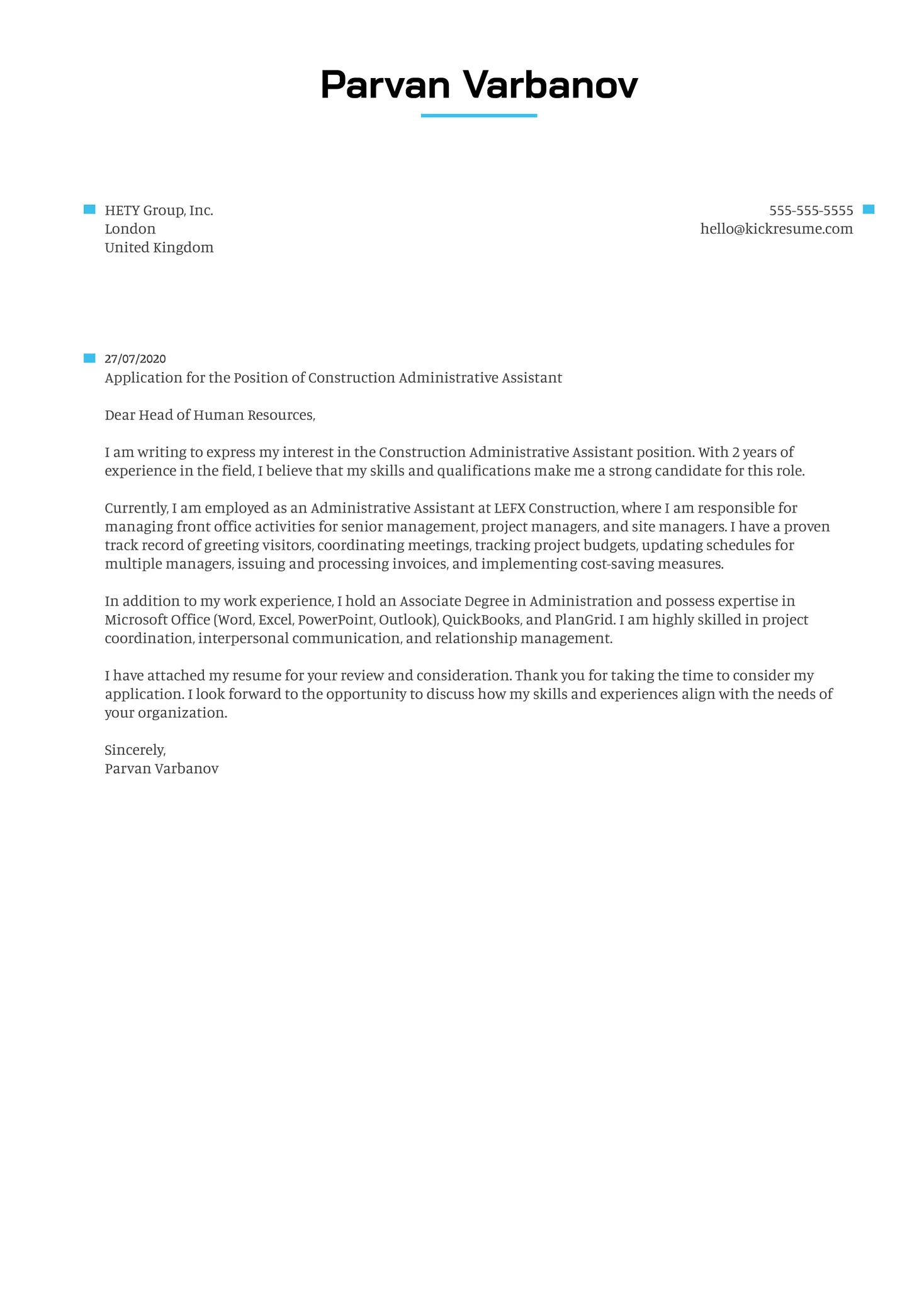
Many companies use Applicant Tracking Systems (ATS) to screen cover letters and resumes. To increase your chances of passing through the initial screening, use relevant keywords strategically throughout your cover letter. Identify the keywords in the job description and incorporate them into your letter, particularly in the skills and experience sections. However, avoid keyword stuffing, which can make your letter sound unnatural and unreadable. Focus on using keywords in a natural and contextually appropriate way. For example, if the job description mentions “project management,” incorporate that term into your description of project management experience and any relevant responsibilities or achievements you are mentioning.
Formatting and Design Tips
The formatting and design of your cover letter are just as important as the content. Use a professional font like Arial, Calibri, or Times New Roman, and maintain a consistent font size and style throughout. Keep the letter concise, ideally no more than one page. Use clear headings, bullet points, and white space to make the letter easy to read and visually appealing. Ensure your letter is well-organized, with a logical flow that guides the reader through your skills and experiences. Before sending your cover letter, proofread it carefully to ensure there are no typos or grammatical errors. A well-formatted and designed cover letter demonstrates your professionalism and attention to detail.
Maintaining a Professional Tone
Your cover letter should maintain a professional and respectful tone throughout. Avoid using overly casual language, slang, or jargon. Use formal language and proper grammar, punctuation, and spelling. Address the hiring manager by name, if possible, and avoid generic greetings like “To Whom It May Concern.” Express your enthusiasm for the role and the company, but avoid being overly enthusiastic or boastful. Focus on your qualifications and how you can contribute to the company’s success. When mentioning your achievements, be specific and provide concrete examples. Always remain positive and confident in your abilities. The tone of your cover letter reflects your communication skills, which are essential for executive assistants.
Proofreading and Editing
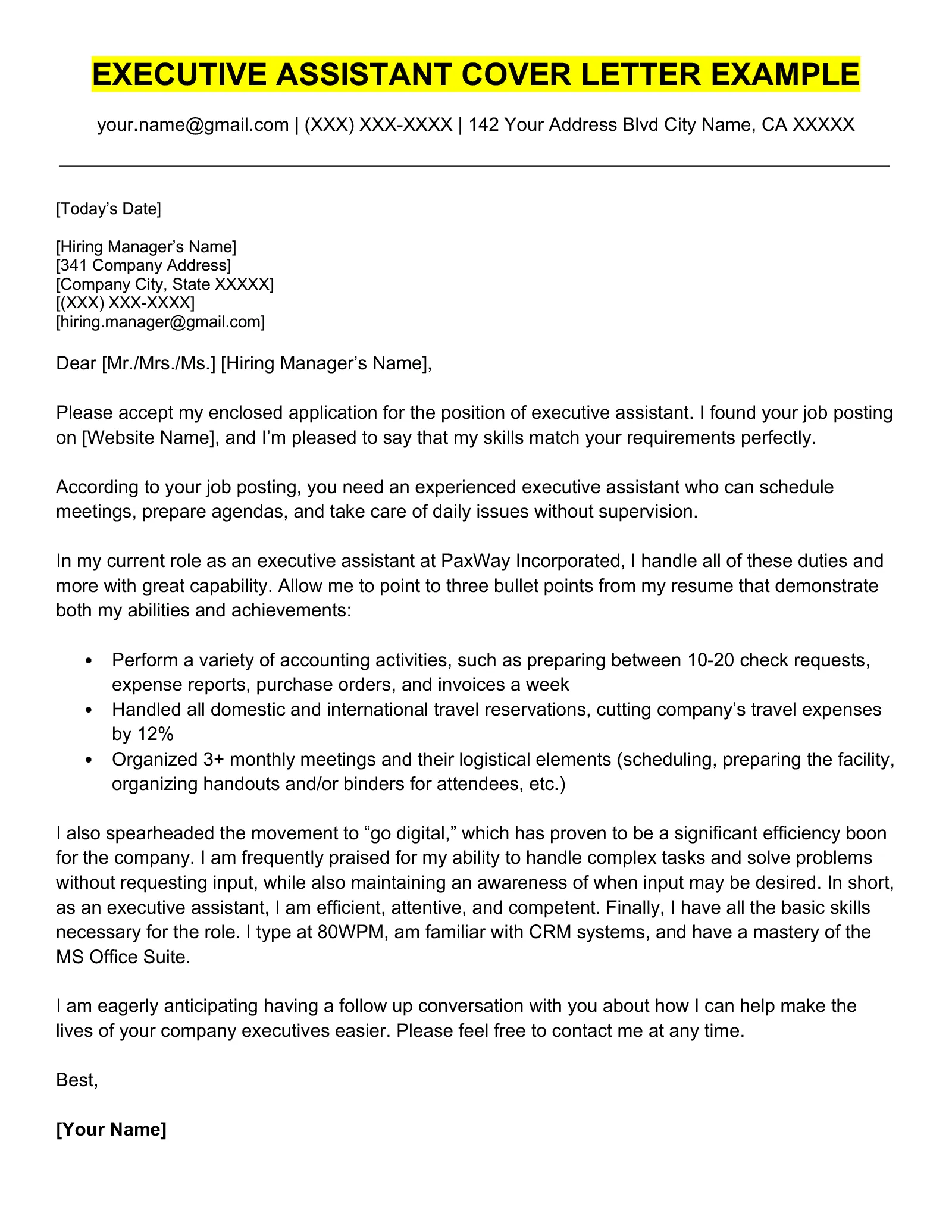
Proofreading and editing are crucial steps in the writing process. Before submitting your cover letter, carefully proofread it for any grammatical errors, typos, and inconsistencies. Read the letter aloud to catch any awkward phrasing or sentences. It is also helpful to have a friend, colleague, or career counselor review your cover letter. They can provide an objective perspective and identify any areas that need improvement. Pay close attention to your contact information to ensure it is accurate and up-to-date. A polished and error-free cover letter demonstrates your attention to detail and professionalism. Using tools like Grammarly can help catch errors you might miss.
Call to Action and Closing
End your cover letter with a clear call to action and a professional closing. Express your interest in an interview and state that you are eager to discuss your qualifications further. Provide your contact information again for easy access. Use a professional closing such as “Sincerely,” “Best regards,” or “Yours sincerely,” followed by your typed name. Avoid informal closings like “Thanks” or “Best.” Thank the hiring manager for their time and consideration. A strong closing reinforces your interest in the role and encourages the hiring manager to take the next step.
Cover Letter Examples for Executive Assistants
Reviewing cover letter examples for executive assistants can provide valuable insight into how to effectively showcase your skills and experience. Look for examples that highlight communication skills, organizational abilities, and proficiency in administrative tasks. Pay attention to how the examples address specific job requirements and showcase relevant achievements. You can find many templates online, but always remember to customize them to match your unique qualifications and the specific job description. Also, note the different approaches, and adapt the tone and style to suit your personality. This will help you create a cover letter that genuinely represents your abilities and increases your chances of landing an interview. Here are some tips to start, personalize the templates, highlight relevant achievements, and match the tone and style.
